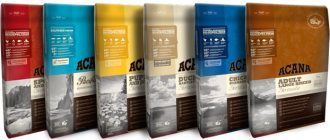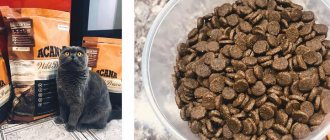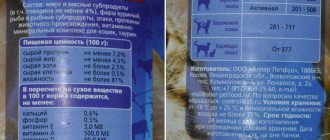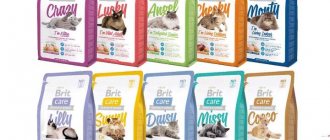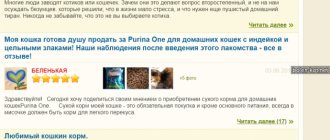Is it true that after sterilization, not only the behavior of domestic cats changes, but also their physiological needs, in particular, they require different nutrition? How critical is it to continue feeding them the same food? What criteria should you look for when choosing a diet for sterilized and neutered male cats? We will talk about all this in our article, and at the same time we will tell you which Acana and Orijen products can be considered for feeding this large group of pets.
Components: what does it contain?
Veterinarians advise giving preference to food in which the ratio of meat and fish to other ingredients is >65%. The higher the indicator, the better the product.
Canadian premium cat food has passed international quality certification and is recommended as the main component of a pet’s diet. The composition of dry pads consists of 70% meat or fish, which are the main source of protein. There are no vegetable lipids or grains not recommended by veterinarians. Smoked meats, spices and additives are also excluded. The Wild Prairie line combines chicken, turkey meat and liver, the Pacifica includes hake, flounder, herring and pollock, and the Grasslands includes lamb, duck liver, salmon, perch and herring. Additional components that improve the pet’s immune defense and coat structure include the following:
Legumes act as auxiliary components in the diet to strengthen the immune system.
- Beans: peas;
- chickpeas;
- lentils;
- beans.
- corn;
- blueberry;
- carrot;
- ginger root;
- magnesium;
Advantages of Akana food
If your pet is obese, it is recommended to give Akana food, as it helps to establish processes in the body that are responsible for normalizing weight.
No preservatives or coloring substances are added to the dry pads, so the product is suitable even for babies up to 10 months, as well as sick and especially picky cats. Acana food has been certified and meets international standards. Veterinarian and nutritionist Olga Ulyanova also recommends the Canadian product for obese cats. Since the basis of the food is proteins with a minimum of carbohydrates, with regular consumption the animal’s blood glucose concentration is normalized, which leads to weight stabilization. Veterinarians consider the following to be the main advantages of a premium cat product:
- High content of meat and fish products in relation to other components.
- An exact indication of the mass of each ingredient in the composition.
- Hypoallergenic.
- Omega-3 content, which improves the condition of the coat.
- Freshness and naturalness of products without freezing.
- No preservatives, coloring agents or taste stimulants.
- The presence of meat grown in environmentally friendly conditions, without the addition of hormones and antibiotics.
- High mineral content with precise elements specified.
- Refusal to add cereals, which complicate the animal’s digestion.
Dry diets Acana and Orien for sterilized cats
Although none of the Canadian Acana and Orien foods are labeled Sterilized, each of them, except the kitten diet, is ideal for feeding a cat after sterilization. Based on facts, the practice of veterinarians and scientific data, the manufacturer produces the same products for cats of different hormonal status. Taking into account all of the above, this approach seems to be the most honest and quite reasonable. All Acana and Orien foods are distinguished by:
- high content of quality meat/poultry/fish (from 75% to 85%);
- a very small proportion of carbohydrates - only in fruits and vegetables;
- a verified balance of magnesium, phosphorus and calcium - and not in threshold values, but in the most optimal ones;
- useful supplements of medicinal herbs, berries, pre-probiotics.
From the offered assortment of AKANA, you can choose diets for adult cats with chicken and turkey, lamb and duck, or only with ocean fish in the composition. Within the ORIJEN brand, in addition to similar tastes, there is also a specialized diet for cats prone to obesity - Orijen Fit & Trim. It has a reduced fat content (15%) and a high fiber content (6%), making it ideal for sterilized pets whose appetite and metabolism need to be regulated after surgery.
Please note that in the feeding table there is a separate column for cats that are already overweight, as well as a column for “for prevention”.
If your animal eats less than the norm, leaving granules in the bowl every day, this is not scary, because deviations within 10% are quite acceptable, but if it does not eat enough (objectively judging by the weight and condition of the animal, and not according to its requirements), even taking into account allowances - it’s worth weighing your pet again, perhaps switching to a higher-calorie product or consulting with a veterinarian*.
We would also like to remind you that when feeding dry food, a cat should consume 2.5–3 times more water than its portion weighs. For example, if you ate 10–15 g, you drank 25–35 ml of liquid immediately or after some time. This process must be controlled to avoid diseases. Adequate and regular drinking plays the same role in the diet of a sterilized cat as properly selected food. And the quality of the latter in no way can replace/make up for the lack of moisture! If you can't get your animal to drink enough liquid, you should consider wet ready-made food rather than extruded food.
*For all questions regarding feeding cats with Acana and Orijen diets, you can get advice from our veterinary specialist or company managers - write in the dialog box in the lower right corner of the page.
How much should you give your cat?
If the cat has previously eaten other food, then Acana should be introduced gradually, adding 10-20% to the pet’s standard menu. The full transition takes place in 7 days.
To avoid overeating, it is necessary to monitor the daily intake of the product, and the animal should always have access to water.
Manufacturers do not recommend combining several Acana varieties, as this is fraught with gastrointestinal disorders. You need to choose one flavor that your pet will like most. Three meals a day at equal intervals are shown. It is important to monitor portion sizes, as overeating is fraught with complications for the gastrointestinal tract. Serving size is calculated based on the weight of the animal. The standard volume varies from 20 to 100 g per day. There should be clean water next to the food bowl. If your pet has scabies, rashes, or the condition of the fur has worsened, then you need to switch to another product.
What does it mean – metabolism changes?
Surgical intervention in the sexual functions of an animal, be it castration of males or sterilization of females, inevitably leads to a restructuring of the hormonal balance: in fact, the entire body begins to work somewhat differently.
Outwardly, this is expressed in a change in character : cats become lazier and calmer, and they are much less concerned about issues of territory and place in the pride - but interest in food, on the contrary, increases.
Combined with a sedentary lifestyle, this can lead to weight gain and, if uncontrolled by the owners, to obesity.
Excess weight and insufficient exercise can provoke in sterilized cats, for example, a tendency to develop crystalluria. It is also often called urolithiasis, which is not entirely true - what most often forms in the urine of animals is not stones as such, but many struvite crystals. Despite their small size, they can injure the walls of the bladder, thereby causing inflammation.
To protect a neutered pet from the negative consequences of sterilization, it is recommended to choose a new diet for him that is maximally adapted to the new lifestyle. So, what food should you feed your sterilized cat?
Disadvantages of use
The main disadvantage of premium food is its high cost. However, the price pays off due to the rapid saturation of the pet. "Akan" does not have special food intended for animals with chronic diseases, therefore in case of serious disorders you should first consult with a veterinarian. Also, the Canadian manufacturer does not produce separate lines for sterilized and neutered cats, so if consumed regularly, the animal may develop urolithiasis.
But according to veterinarian and nutritionist O. Ulyanova, a high content of Mg and P minimizes the likelihood of the disease, since these microelements act as a preventive measure for urolithiasis. Reviews from pet owners confirm that the food is suitable for neutered cats and does not cause health problems. But, if your pet has difficulty defecating, he needs to eat other foods with a higher content of plant fiber.
Sterilized: Cannot be neglected
As you probably guessed, the whole point of the title is where the comma is placed. And the whole paradox is that the truth will be in both readings. The fact is that the main difference between the diet for sterilized cats and the usual one is the reduced fat content. But let’s start with the fact that not all cats (due to their character, constitution or peculiarities of keeping) begin to gain weight after sterilization, and not all require special food. If your pet from this category continues to frolic, run around, play, and eats no more than before, you can relax and not waste time choosing new food, provided that you follow the basic principles of healthy and proper nutrition for your cat.
Another problem is that the Sterilized label does not automatically guarantee the quality of the food, it is just a technique to attract the attention of the consumer. Accordingly, on sale you can find both decent products for sterilized cats and food with extremely low biological value, so we recommend taking a break from the labels and looking at the composition indicated in small print on the label. Keep Focus:
- Sources of protein and fat. For cats and kittens, both sterilized and non-sterilized, it is equally important to eat animal sources of protein and fat, therefore food marked Sterilized, where instead of high-quality meat and meat products, cereals are in first place, and there is no chicken, no fish, or any or other fat, but only vegetable oil - immediately cross it off the list.
- Excess carbohydrates in a cat's diet. You must always remember that cats do not require carbohydrates in principle, and their excess loads the pancreas, leads to digestive disorders and contributes to the alkalinization of urine in predators - the latter factor plays an important role in the occurrence of urolithiasis. If you see that food “for castrates” contains more grain of any kind or potatoes than meat, you should refuse it, even if it contains useful additives that “acidify” urine - cranberries, lingonberries.
- Correct ratio of minerals. For sterilized cats, this is especially important in their daily nutrition. And although deviations from industry norms in this regard are rare (if we are talking about complete industrial feeds), it still doesn’t hurt to check the “dark horse”. Veterinary experts from AAFCO and FEDIAF (authoritative associations that recommend standards for the food industry) agree that the ratio of calcium to phosphorus in dry cat food should not exceed 2:1. You can find out this value by dividing the proportion of calcium by the proportion of phosphorus. This data should be in a guaranteed analysis on the food label: for example, 1.4% Ca divided by 1.1% P - the result is 1.27: 1 - ideal. The proportion of magnesium is also important - optimally, if it is not lower than 0.045 g per 100 g of dry matter of feed.
- Feed fat content . If you know that your cat is prone to obesity or has already gained excess weight, choose diets with a fat content in the range of 12–17%. If there is no such problem, do not pay attention to fat content, because fat is very important for the health of predators: it is a source of Omega series polyunsaturated acids and is responsible for many functions in their body.
